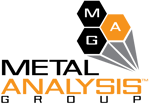EXPERT APPROVED: LIBS
Expert-Approved LIBS Analyzers from Metal Analysis Group
In the realm of material analysis, technological advancements continue to reshape our approaches and capabilities. The advent of handheld X-ray Fluorescence (XRF) analyzers has significantly altered the landscape, enabling swift and accurate assessments of materials within the supply chain. This shift towards immediate analysis has not only bolstered productivity and safety across various industries but has also proven instrumental in enhancing profitability and saving lives. At the heart of this transformation lies the versatility and accessibility of XRF technology, offering a cost-effective solution for verifying materials' compliance with stringent regulatory standards.
Handheld XRF instruments boast the capability to measure elements spanning the periodic table, from magnesium to uranium. However, their limitations become apparent when attempting to determine lighter elements such as carbon. Historically, mobile Optical Emission Spectrometry (OES) has been the preferred method for carbon analysis in materials like low alloy carbon steels and stainless steels. Yet, the cumbersome nature of mobile OES instruments, coupled with their limited maneuverability, has spurred the quest for alternative solutions.
Enter Handheld Laser Induced Breakdown Spectrometry (LIBS) analyzers, offering a promising avenue for detecting and quantifying light elements, including carbon, with comparable portability to handheld XRF devices. Operating on the principle of creating a plasma through laser-induced breakdown, LIBS technology excels in providing insights into elemental compositions, albeit with distinct sample preparation requirements compared to XRF.
The choice between handheld XRF and LIBS hinges on specific application requirements. Handheld XRF shines in its accuracy for metallic materials, particularly those rich in alloying transition metals or refractory metals. Conversely, handheld LIBS emerges as the method of choice when precise quantification of carbon and other light elements is paramount, as in metal fabrication or positive material identification scenarios.
Combining the strengths of both techniques opens new vistas in material analysis. Positive material identification programs, critical for ensuring asset safety and integrity in industries like oil and gas, benefit immensely from the complementary capabilities of handheld XRF and LIBS. By harnessing these technologies in tandem, inspection companies can achieve unparalleled maneuverability and analytical depth, facilitating comprehensive material verification in diverse environments.
Industries such as aerospace, automotive, naval, and oil & gas stand to reap substantial benefits from the synergy between handheld XRF and LIBS. While XRF has revolutionized non-ferrous metal analysis over the past decade, LIBS is poised to replicate this success in carbon and low alloy steels, offering unparalleled accessibility and analytical precision.
In the quest for accurate and reliable elemental analysis, technological innovation remains paramount. The convergence of handheld XRF and LIBS exemplifies this spirit of innovation, heralding a new era of efficiency and accuracy in material characterization and verification. As we continue to push the boundaries of scientific inquiry, these advancements pave the way for safer, more sustainable industrial practices.
